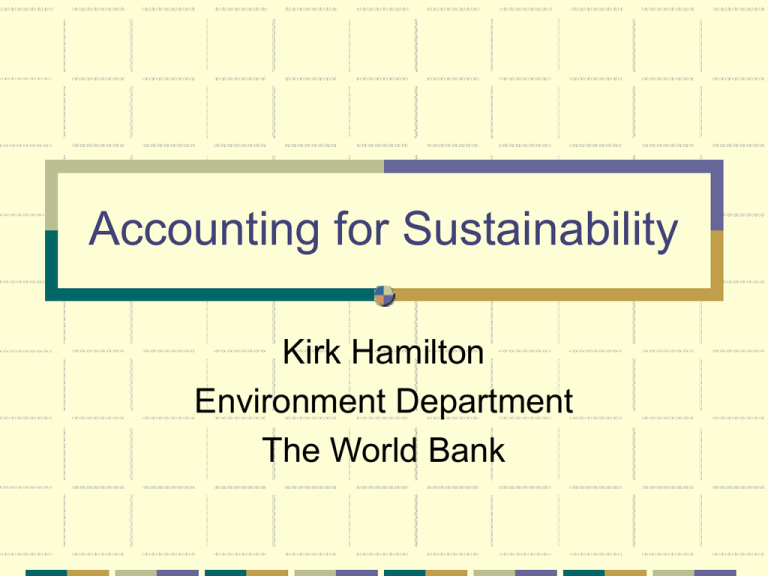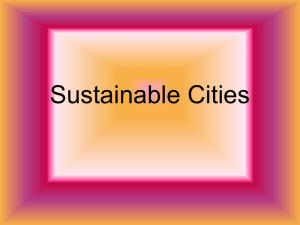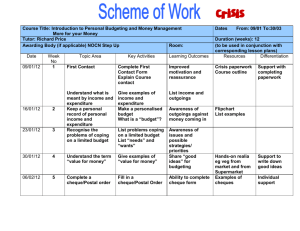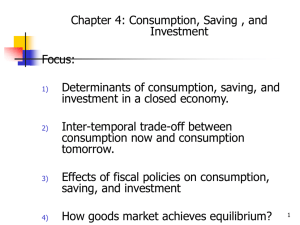Accounting for Sustainability
advertisement

Accounting for Sustainability Kirk Hamilton Environment Department The World Bank Outline Approaches to SD indicators Net or ‘genuine’ saving Issues – concepts, measurement Approaches to SD indicators Extended national accounts: SEEA, net (genuine) saving, genuine progress indicator / ISEW Biophysical accounts: ecological footprint Unweighted indices: environmental sustainability index, Living Planet index Weighted indices: environmental pressure indices Eco-efficiency: resource flows / GDP Indicator sets: UN CSD, various countries Desirable characteristics for SD indicators Underlying framework Numeraire / aggregation rules Clear interpretation regarding sustainability Linkage to policy levers through aggregates or sub-aggregates Net (genuine) saving Net saving is the change in the real value of all assets (investment minus depreciation minus net foreign borrowing). Net saving = (PV of social welfare)-1 Positive genuine saving indicates rising social welfare; negative genuine saving indicates that social welfare will fall in the future. Composition of net saving, 1999 Gross ConsumpNet Carbon domestic tion of fixed Energy Mineral forest dioxide Education Adjusted net savings capital depletion depletion depletion damage expenditure savings Low income Middle income Low & middle income High income 20.3 26.1 25.2 22.7 8.3 9.6 9.4 13.1 3.8 4.2 4.1 0.5 0.3 0.3 0.3 0.0 1.5 0.1 0.4 0.0 1.4 1.1 1.2 0.3 2.9 3.5 3.4 4.8 7.8 14.3 13.3 13.5 East Asia & Pacific Europe & Central Asia Latin America & Carib. Middle East & N. Africa South Asia Sub-Saharan Africa 36.1 24.6 19.2 24.2 18.3 15.3 9.0 9.1 10.0 9.3 8.8 9.3 1.3 6.0 2.8 19.7 1.0 4.2 0.2 0.0 0.4 0.1 0.2 0.6 0.4 0.0 0.0 0.0 1.8 1.1 1.7 1.7 0.4 1.1 1.3 0.9 1.7 4.1 4.1 4.7 3.1 4.7 25.2 11.9 9.6 -1.3 8.3 3.9 Adjusted net saving vs GDP/cap 1999 50.0 40.0 Adjusted net saving, % of GDP 30.0 20.0 10.0 0.0 100 1000 10000 -10.0 -20.0 -30.0 GDP per capita 100000 Wealth/capita vs population growth, 1999 14% 12% 10% Change in wealth per capita, % of total 8% 6% 4% 2% 0% -1% 0% 1% 2% -2% -4% -6% -8% Population growth rate, % 3% 4% Conceptual issues Asset accounts in monetary units provide a consistent framework and yardstick for measuring development prospects. The components of net saving (gross saving, depletion, damage) can be affected by policy, permitting tradeoffs in the pursuit of sustainability. Conceptual issues (2) Negative net saving indicates unsustainability by standard definitions. The saving measure is directly related to a looser definition of sustainability: non-decreasing present value of social welfare. Measurement issues Valuing stocks or changes in stocks is difficult because it requires assumptions about the future. Certain environmental problems are difficult to handle – e.g. vertical marginal damage curves, biodiversity. Trans-boundary pollutants (including CO2) require assumptions about property rights. Measurement issues (2) Social issues are problematic because of the difficulty in identifying and quantifying relevant assets and flows. Aggregate asset values and adjusted income measures are not particularly useful for measuring sustainability. Net saving, the change in the real value of assets, is directly relevant for measuring development prospects. Conclusions Net saving has a strong basis in theory, and empirical testing is promising. Complementary biophysical indicators will probably always be required. Net saving is a more useful indicator as the breadth of assets accounted increases. Even with the World Bank’s limited asset coverage, there are 10-20 countries each year with negative net savings.





